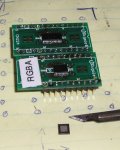OT: Free to good home - 32-QFN TLC5940 PWM LED Driiver
- Thread starter JimPerry
- Start date
mrburnette
Senior Member
Jim, Radio Shack sells an under $6 U.S. QTFN adapter board if your need to purpose the chip for prototyping...Does what it says on the tin - too small for me to deal with PM if you can use it
QFN Adapter #:14168345
- Ray
mrburnette
Senior Member
Totally understand... my eyes are aging and I have had to resort to an old surplus stereo 1X-10X microscope secured from eBay. I had some samples of the smaller chips and had a friend solder them to the adapter boards with breadboard pins... I'm afraid that DIP packages are getting nearly impossible to secure for samples. Best of luck...I'm OK with SSOP etc - but the QFN is a step too far for me - sample was free to me from TI - and I've been diagnosed with early cateracts in both eyes
- Ray
The problem with soldering that package is not so much soldering the pins on the periphery, (you can probably "blob-solder" them, then solder-wick off the excess.) The problem lies in soldering the center pad so you get a good thermal connection to ground to keep the chip cool enough to meet its specs. That typically requires paste solder to coat the pads and an SMT oven to do the soldering.
However, you can usually manage it with a soldering iron if directly beneath the center of the chip on the PCB there is a reasonably large, plated-through, feed-through hole (via) in the PCB through which you can flow solder. These are often designed int such PCB, in order to more effectively distribute the chip's heat to both sides of the PCB.
However, you can usually manage it with a soldering iron if directly beneath the center of the chip on the PCB there is a reasonably large, plated-through, feed-through hole (via) in the PCB through which you can flow solder. These are often designed int such PCB, in order to more effectively distribute the chip's heat to both sides of the PCB.
Solder
Send me a board and the chip and ill reflow it for youThe problem with soldering that package is not so much soldering the pins on the periphery, (you can probably "blob-solder" them, then solder-wick off the excess.) The problem lies in soldering the center pad so you get a good thermal connection to ground to keep the chip cool enough to meet its specs. That typically requires paste solder to coat the pads and an SMT oven to do the soldering.
However, you can usually manage it with a soldering iron if directly beneath the center of the chip on the PCB there is a reasonably large, plated-through, feed-through hole (via) in the PCB through which you can flow solder. These are often designed int such PCB, in order to more effectively distribute the chip's heat to both sides of the PCB.

